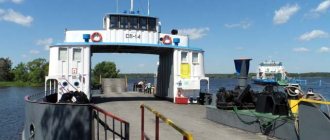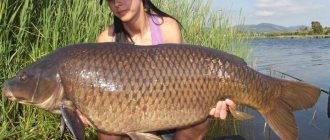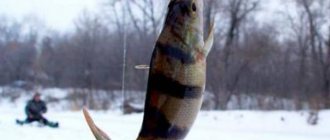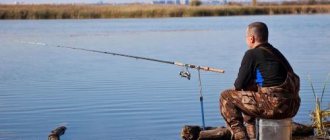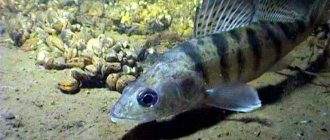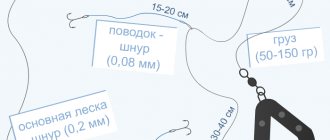A little about the Moscow Canal
Take a look at the map of the Moscow region - in its northern part, from Moscow to Dubna, there is a canal connecting two mighty rivers (the Volga and the Moscow River).
Thanks to the efforts of the pre-war five-year plans, it was built in record time, subsequently becoming the main water transport artery of the region. In addition, the capital receives the lion's share of drinking water from the Ivankovo reservoir, pumping it through a canal.
The length of the Moscow Canal is approximately 130 km. There are 8 locks and a whole cascade of reservoirs (Pestovskoye, Uchinskoye, Klyazminskoye...). The average width of the canal is 100 m, the average depth is about 5–6 m.
The canal is home to a wide variety of fish - from the ubiquitous small bleak to large catfish, whose weight sometimes exceeds 20–25 kg. In the waters of the canal there are such predators as pike perch, perch - the main objects of hunting for spinners, asp, catfish, saberfish, sometimes ide and chub are caught on a hook, and very rarely - pike.
The Moscow Canal, like other canals, is a purely artificial reservoir. During its construction, the interests of our brother, the fisherman, were least taken into account... Fishing on the canal is complicated by constant shipping, which results in variable currents. In addition, most predators, pike perch in the first place, do not live in the canal permanently; they enter it in early spring and leave in late autumn. They winter, as a rule, in reservoirs adjacent to the canal.
The behavior of fish of different species in the canal is completely different from the behavior of their counterparts from lakes and rivers comparable in scale to the canal. The bottom topography of the canal has a trough-shaped shape - parallel to the shore, at a distance of 10–15 m from the water's edge, there is a clear, steep edge, followed by a more or less flat and clean bottom. Why is there no place for an ambush predator in the canal? There is nowhere to hide here, so the channel, which is significant, is poor in pike - a typical “ambush”.
True, if you are quite familiar with a certain section of the canal, then you have most likely noticed deviations from the “standard relief”. Depressions running at an angle to the shore, rocky shallows, compact holes, etc. - these places attract the predator first of all, rather than monotonous depths and the absence of any relief.
How and who to catch with a spinning rod on the Moscow Canal?
Now let's take a more specific look at how various predators adapt to the conditions of the canal.
Zander
The most popular fishing object for spinning anglers on the channel named after. Moscow. Its flocks enter the canal in the spring, when bleak also enter it to spawn. After which some individuals settle down and are caught “point by point” throughout the summer. As the weather gets colder, pike perch gather in schools again and migrate from the canal to nearby reservoirs.
The main bait for catching channel walleye is a jig. The weight of the heads of jig baits ranges from 8–20 grams and depends not so much on the depth in a particular place, but on the strength of the current. By the way, the flow of water on the canal has a clear weekly cycle - so on Tuesday the flow is “turned off” to carry out preventive work on the locks. The strength of the current affects pike perch quite strongly.
With a strong draft, pike perch bites occur significantly more than when there is no current or it is very weak. However, in anomalous places (compact holes, hollows, etc.), pike perch can be active even when the current is weak. But this already falls more into the category of exceptions, of which on the channel named after. There are a great many Moscows.
Asp
For me, of all channel predators, this is the most desirable prey! There are not so few asps in the canal. At morning and evening dawns you can observe powerful splashes along the water's edge - this is an asp hunting. However, catching this tireless robber is not so easy. Therefore, if you find yourself on the bank of a canal with the goal of catching an asp, then I do not advise you to “exchange” for other predators. They came for the asp - catch the asp! And carefully think through all the nuances (characteristic habitats in the canal, method of placing bait, etc.) down to the smallest detail.
Channel asp, like pike perch, have seasonal migrations. In the spring, it follows the bleak into the canal in large flocks. But the average size of asps is still small - up to 1.5–2 kg. A little later, when the water warms up even more, real monsters will appear in the canal - asps weighing up to 6-7 kg, and this is not the limit! However, catching such giants is not easy. But it's worth a try.
Around the end of summer, there are noticeably fewer asps in the canal, and they are no longer so willing to take a spoon, so at this time it is better to catch them at the junction of the canal with reservoirs and bays, that is, where a predator can approach.
Asp are traditionally caught “by splash”, using various heavy baits (Devons, spoons). This method is also applicable on the channel, but still fishing “blind” gives a much better result. You arrive at the selected section of the canal and go through it with a spinning rod, making two or three casts of the spoon from one place. Then move about 20 meters - again 2-3 casts... It’s better to cast the spoon at a slight angle to the shore. The fact is that the asp in the canal, as well as in other similar bodies of water (rivers), cruises along the coastline in search of prey. Seeing a flock of bleak on its way, it selects a very specific prey and attacks it. At this moment we see a blow or a powerful breaker on the surface of the water. Or we may not observe anything at all - if the asp sank into the lower layers of water with the cold weather.
Perch
A less popular fishing object among our spinners. But it also deserves a lot of attention. Unlike pike perch or asp, perch does not have such a clear migratory component in its behavior. This is a more or less sedentary predator.
As a rule, it stays in the coastal zone, where it carries out its merciless judgment on the bleak. Further from the shore, perch is found as an exception. The fact is that at a distance from the shore, the perch itself becomes prey to more respectable predators. That's why he doesn't go there. Yes, and hiding behind a coastal dump, you can successfully attack small fish - the main object of perch hunting.
Small wobblers, up to 4–5 cm long, work best as baits. They should be moved unevenly, periodically making short stops. A variety of models work well - both shallow and deep. Spinners and small spinners also catch, but in general they are worse than wobblers.
But wobblers are favorites in the summer. In cold water (spring, autumn) it is easier to catch perch using a microjig. Tiny twisters with light heads (up to 5–7 g). In this case, only the coastal dump and a small area (10 meters) immediately behind it are fished. The type of wiring depends on the mood of the perch on a particular day. But more often it is a classic bottom step. At the very beginning of autumn, you can catch the most perches using jigs.
Sections
Pike perch in the MR are bored in winter... They are chilly from the cold streams, they breathe heavily, they feel bad, they don’t bite. What should we do? It’s kind of sad to wait for spring... But we won’t. Go! Where? Yes, anywhere: Conversations, Chulkovo, Patkino, People's Commissariat of Water Resources, Mikhalevo, Faustovo, Bronnitsy and even Brateevo. Everywhere you can cross paths with large pike perch, the problem is one and very serious - to catch...
The water temperature in the river has been getting lower in recent years. Therefore, areas with warmer water, as well as dead-end migration areas at certain times (usually the vicinity of waterworks and oxbow lakes) are strategically steered.
What does it take to catch a large pike perch on the MP? Favorable day, circumstances of place/time, technique and luck. On MR, you can’t get anywhere without luck in this topic, especially in winter. There are not many large pike perch and it can be difficult to hit a large specimen with bait when fishing in a limited area. What can help here is the fact that large fish (contrary to public opinion) often coexist with their smaller brothers, while occupying a better position on the spot where the school is located. If you calculate it, you can hit the trophy fish right under the nose.
It’s not difficult to choose a “good day”; you just need to carefully monitor the weather conditions. There are now more than enough tools for this. The problem is that there are not many “peak” days in terms of pike perch bite (there may not be a dozen during the winter season) and, of course, they do not always fall on weekends.
And the easiest option to catch a trophy is to wait for the pre-spawning run and the appearance of pike perch in the spawning areas in decent concentrations. But usually all this movement coincides in time with the spring ban and the way there is closed to us - there are enough fools without us.
Another factor that directly affects the activity and movement of fish is the water level, which is usually not stable on the MP. And if you found a pike perch in a specific area yesterday, tomorrow it may not be there at all. This happens only because the level has risen by several centimeters and the current has intensified. However, those who understand where it bounces when the level changes will catch it. The comfort zones of different fish often coincide, so the presence of pike perch in changing conditions can give away, for example, bream.
Pike perch “lives” in the same place where it feeds, or very close. Migration processes are tied to food supply, water level and spawning activities. If the pike perch “has everything” and the conditions are stable, it can stay in one area for a long time and this can be used by thoroughly studying a specific promising place.
Now a little about technology. The easiest way is to catch pike perch “at the peak” of activity, and then overweight, “slippers” and low “strike” wiring will help you (I remind you that there are few such days in winter). Important: the weight of the load needs to be selected for specific conditions, and not make “fifty dollars” according to the principle that the larger the load, the larger the fish - in winter the opposite is often the case. You also need to get the size right. In addition to the standard one, I use the smaller version, and this often helps out.
It is much more difficult to catch a trophy when the fish activity is average. Here it is already mostly light weights and tires that rule. My standard set of such baits looks like this: Gary Yamamoto 4" worm, Pontoon21 Ratta 4.25" vibrating tail and IMA Melthy Nymph 3" vibrating tail. I fish with a ratta and a vibrotail from IMA short (1-2 turns) and low with a light load, with a worm in different ways with heavier loads, but also trying not to tear the bait high from the bottom.
When the activity is even lower (which happens most often), it is very difficult to catch a large pike perch “honestly”. At best, small fish up to 1.5 kg will bite a little. I spent a fair amount of time trying to come up with something for such situations and haven’t given up on experiments yet. But I got positive results in the form of catching 1-2 large fish where there are a lot of large pike perch, but this is no longer our small river. And on the MR at such moments the pike perch usually turns purple and nothing can be done about it...
Where to fish with a spinning rod on the Moscow Canal?
So, now I would like to share my experience of fishing in specific areas of the channel named after. Moscow. Let me note right away that my opinion is deeply subjective and may differ significantly from yours. Be that as it may, over ten years of fishing on the canal I have collected good static information, which allowed me to draw some conclusions and generalizations.
Let's start exploring the canal from the north.
Canal in the Dubna area
The section of the canal from Tempy to the Ivankovskoe reservoir itself is very rich in fish. And pike perch and perch first of all. The channel here is, on average, much deeper than, say, in the Iksha or Morozok area. And the coastal dump comes close to the shore.
The most promising area for hunting predators is the area of the Bolshaya Volga station. There is an old lock next to the crossing. There are many interesting pits, hollows, etc. at the bottom. The main thing is to find them.
Another interesting thing about the canal in the Dubna area is that in early spring this section is the first to be freed from ice. As you know, at the moment the channel is opened, there is a very intense pike perch bite. And the channel is eroded from north to south (this is the direction of the flow in it). Therefore, the site in Dubna may already be open for two weeks and pike perch will be biting here, while, say, in Rozhdestveno or Lobnya there will be strong ice... Keep this in mind and, if possible, try to monitor the current situation on the reservoir.
Dam. Orevo
If you go down the canal a little to the south, then in the Zaprudnya area there is another interesting section. This is the 100th kilometer of Dmitrovskoye Highway. The place can be recognized by two white buoys located closer to the left bank of the canal, which indicate a sharp difference in depth.
This is a great place to hunt for asp. In summer, it stays completely aground, that is, between the buoys and the coastline. Nobody catches it here purposefully, so there are very large specimens, and they are not shy either.
The best time to catch asp is the first half of summer. He most readily responds to bait. The tactics for catching asp have already been discussed a little higher, but it’s worth saying a few words about bait. For bait, I recommend using oscillating spoons made of thick metal, as well as jigs. The main thing is that at high speed the spinner does not go into a corkscrew and does not fly to the surface. The spoon should go one or two palms below the surface of the water and stably hold the specified horizon.
The lure should be played at an average or slightly accelerated pace. The weight of spinners is usually 15–20 g. Do not be afraid of large spinners. The asp is not a small fish, you won’t scare it away with a big spoon. But the perch will annoy small baits, which does not fit into our goal - to catch an asp.
The sharp edge, which runs 50–60 meters from the shore (it is marked by buoys), is interesting in terms of pike perch, and also catfish. Catfish are known to eat up to 80 percent of their annual diet in May. That is why the vast majority of catfish catches occur in this month. And the pike perch stays under the buoys all the time. Here, increased demands are placed on the range of the tackle: you need to throw it across the fairway with a reserve - bites sometimes happen at the maximum distance from the shore.
Canal near the village. Orevo is interesting, first of all, for catching pike perch. There used to be a pier on the site of the existing boat crossing. And there is a lot of debris left at the bottom (piles, scrap metal, etc.) - this is very attractive to pike perch. He stays here all the time. It is best to use non-hooking to minimize the number of annoying losses on the hooks. The weight of weights for jig baits depends on the strength of the current - usually 12–15 g.
Dmitrov. Yakhroma
Here the canal is already much more crowded - mountains of plastic bottles, crowds of people swimming - all this does not suit the fisherman very much!
There is an extension on the canal in the Dmitrov area. If you use a boat and swim out to the edge of the riverbed, you can successfully hunt for pike perch; catfish bites are also common. About three years ago, a giant catfish weighing more than a pound was caught in this place. The easiest way to find the channel edge is with an echo sounder, but it can be visually identified by the white buoys. Pike are sometimes found here, although this is a very rare visitor in the canal.
From the shore this section of the canal is also interesting, but along the right bank the riverbed approaches it closely.
There is a long sandbank along the left bank; perch are constantly present on it. In spring you can also find ide, and quite a large one at that. At dawn the asp carries out his judgment over the bleak. It's easier to catch him with a long-range castmaster. Along the shallows, the asp is already more dispersed, so it makes sense to fish further afield, and not just the coastal zone, as usual on the canal. However, in mid-summer this shallow area becomes heavily overgrown with algae, so you can only catch coastal perch without any problems. The best bait is considered to be a wobbler.
The section of the canal from Yakhroma to Tourist is somewhat more interesting. It’s not so crowded here anymore, and you can easily catch a wide variety of predators. Zherekha - on the canal itself and next to the lock near the station. Yakhroma, pike perch on the edge, located almost in the middle of this area and is easy to find by its white buoys. And the perch is found at the exit of the canal from the lock, although it is present throughout the section from Yakhroma to the station. Tourist.
Frosts. Iksha
Near the station Morozki from the canal on the left bank there is a channel connected to a large bay. There are a lot of pike and perch in it. They usually fish here from a boat.
The point of connection of the duct with the canal is interesting. In this area, the constantly changing current and water level create alternating currents that strongly attract a wide variety of fish. Of greatest interest is night fishing for pike perch using wobblers. It is better to use models that go shallow - up to a meter maximum.
The road along the left bank of the canal from Morozok and upstream leaves much to be desired - therefore, if you get carried away to those parts, you will have to cover an impressive section on foot.
The area between the two locks in Iksha is interesting, primarily in terms of hunting for pike perch and catfish, especially in early spring, immediately after the opening of the canal. A lot of fish remain to spend the winter here - the sluices are closed all winter, so they have nowhere to go.
It is important to get directly to the moment when the channel is cleared of ice. The current is “turned on,” which forces the fish to actively move in search of prey. In summer or autumn, the pike perch in the area between the locks is not as active as in the spring, therefore the bites are significantly less, and so is the size. A typical bait is jig - the weight of the heads is 12–18 g and depends on the strength of the current.
There are plenty of places for fishing, the only drawback is the proximity to the road - so it’s always crowded. But there is excellent access - from the platform to the canal 200 m.
Labor
This refers to the well-known section between the Ikshinsky and Pestovsky reservoirs - the “pipe”. Very good place. Lots of different fish. However, not everyone is caught. Fishing is complicated by the constant search for active schools of pike perch. The fact is that pike perch and other fish (well, maybe except perch) enter the “pipe” from adjacent reservoirs and do not stay there permanently. The migration processes of fish here are very pronounced. Anglers catch either a lot or nothing!
You can count on the greatest guarantee of a bite at the junction of the canal with reservoirs. If you stand on the “upper” cape (that is, at the junction of the channel with the Ikshinsky Reservoir) and cast about 10–11 o’clock towards the fairway, you can almost always count on a bite from pike perch, and sometimes from catfish. The trouble is that in 9 cases out of 10 this place is occupied by donors, and it is better not to enter into conflict with them...
At the other end of the “pipe” (and its length is four kilometers), near the Pestovsky Reservoir, there is also a good place for catching pike perch and asp. It is better to catch pike perch again from the cape, while asp more often finds itself somewhere in the canal itself. This part of the “pipe” is much less crowded, so you can choose a suitable place.
Another point is night fishing for pike perch on the capes. In these places, the shoal extends at an angle to the shore, then abruptly drops off into the depths. Pike perch comes out to shallow areas at night and is caught very well using wobblers and jig baits with a small weight. It is better to take a jig bait of a regular size (medium foam rubber or twister) and with a large hook - otherwise you will not end up with empty hooks. But the weight of the weights needs to be reduced, since the depth at the fishing spot is not great at all. The average weight is 6–8 g. The stepped retrieve is quite acceptable, and pike perch is caught very well.
As for the asp, its presence in the “pipe” is determined by the concentration of the fry at a given moment. When the bleak enters the canal, the asp enters after it. It is better to catch it using oscillating spoons according to the classic scheme described at the very beginning of the article.
As for the access to the canal, it is good - asphalt to the water. But it’s better to travel along the canal on foot. In a car, especially with a low seating position, you can get into trouble - the road is “death to the enemy”! Therefore, it is better to leave the car at the ferry.
Sunny glade. Stepankovo. Novoseltsevo.
The area between the villages of Stepankovo and Novoseltsevo does not stand out as particularly remarkable. Usually pike perch is caught here, less often perch. But pike perch is small - up to 1 kg, rarely more. In addition, the most promising places for a spinning angler are almost always occupied by bottom spinners. They are not there except in winter...
In addition, the access to the water was blocked several years ago with a barrier - entry became paid. Not the best places for fishing, and even for the money...
Near Solnechnaya Polyana and the village of Vitenevo with better pike perch. Larger specimens are found - up to 2 kg or more. Access to the water is not very good - the road washes out after rains. But, leaving the car in the village, you can walk about half a kilometer to the water.
Both the canal itself and the adjacent bays are interesting. But there are more perch and pike in the bays, and it’s more convenient to fish from a boat. There are a lot of asps in these places, and they are not so shy. And at the beginning of summer, seasoned sherespers come from reservoirs - weighing more than 5 kg.
Species composition of fish
The species composition of fish in the Moscow Canal is quite diverse. It contains many species of peaceful and predatory fish. However, the following trophies are more often found on fishermen’s gear:
- bream;
- roach;
- bleak;
- zander;
- asp;
- perch.
On this reservoir, fishing for bream using a feeder is very popular. Feeder fishing competitions are regularly held on the canal, so catching bream, spoiled with good bait and thin tackle, is not at all easy.
On a note! There is a current in the channel, and in addition, effective fishing often requires a long cast of the feeder, which leaves an imprint on the construction of gear and installation of equipment.
For this reservoir, you need a fairly powerful feeder rod with a test weight of up to 80 g. With such a rod, you can comfortably cast large feeders filled with food, and not worry that they will be blown away from the feeding point.
The length of the feeder should be no shorter than 3.9 m, which will allow you to make long casts and reduce the number of hooks on the feeder on steep riverbed edges. The feeder fishing rod is equipped with a 3500 series spinning reel, on the spool of which a braided cord with a diameter of 0.12 mm is wound. The bottom of the channel is rocky, so the presence of a fluorocarbon leader in the equipment is mandatory. Each fisherman uses his own installation of feeder equipment, but as practice shows, an asymmetrical loop works better on this reservoir. You need to constantly experiment with the leash length and hook number, depending on the activity of the fish and the strength of the current.
On the banks of the Moscow Canal you can always meet fans of feeder fishing
On the canal, bream is usually caught on the far or near edge of the channel. The nearest edge is located 25–30 m from the shore. To cast to the far edge, the angler will have to cast 50–60 m. The current on the canal is weak, so it is not necessary to add soil to the bait mixture.
Depending on the fishing season and the mood of the bream, it can bite on the following bait options:
- a bunch of 2-3 bloodworms;
- dung worm;
- bloodworms with maggots;
- maggot.
The best time for bream fishing on the canal is August and September. During these months, the capture of a trophy specimen is most likely.
Roach on the Moscow Canal are often caught on the feeder when fishing for bream. It is better to catch it purposefully with a fly rod. For fishing for roach, fly rods 5 and 9 meters long are well suited.
A 5-meter long rod allows you to catch small roach on a nearby underwater ledge. A longer fishing rod will allow you to reach the next “table”. The equipment for fishing this fish should be extremely light, and the length of the leash should be at least 20 cm.
Important! When fishing for roach on a canal, bait is of decisive importance, which must be constantly thrown into the water, not allowing the bait column to settle.
Small and medium roach in this reservoir are well caught using bloodworms. Larger specimens prefer to peck on boiled pearl barley and rolled oatmeal flakes.
There are a lot of bleaks on the channel, but they are extremely small and often interfere with fishing for other white fish. You can catch bleak on short fly rods using maggots as bait. Any fine-grained mixture designed for catching white fish and having a light color can serve as bait.
Pike perch is the main fishing target for most spinning anglers fishing on the Moscow Canal. This predator comes to the canal in the spring, hoping to profit from spawning bleak. Some individuals remain in the canal and occupy the most promising areas. With the autumn cooling of the water, the “fanged” one again gathers in flocks and goes to nearby reservoirs. As a rule, pike perch on the channel respond better to jig baits. The weight of the jig heads used depends on the strength of the current and can range from 5 to 25 g. The strength of the current in the channel greatly affects the bite of pike perch. Strong traction activates the predator, and it attacks the bait more greedily.
Some fishermen manage to catch carp on the canal
Asp fishing on the canal is very interesting. Catching this predator on the canal is quite difficult, but the process of catching becomes more interesting. Just like pike perch, it enters the canal following the bleak that has arrived to spawn. In spring, the size of the asp in this reservoir exceeds 2 kg, but as the water warms up, real giants come here and are very difficult to catch. You need to catch an asp based on the splash created by this fish when hunting for fry.
The best baits for fishing in this reservoir are:
- small wobblers;
- Devons;
- oscillators.
During the hunt, the asp in the canal is in constant motion, cruising along the coastline. Seeing a bleak emerge from the shallows, he instantly rushes at it, giving himself away with a loud splash.
Perch on the channel is not as popular among spinners as asp and pike perch, but it still often helps out in the absence of biting from other predators.
Interesting! The bulk of perch in the canal sticks to the coastal zone, since far from the shore it itself turns into an object of hunting for larger predators. The perch hides behind the near shore edge and from time to time raids schools of bleak.
In summer, on this reservoir, he prefers to peck on small wobblers up to 5 cm long, while both shallow and deep-water options work. In addition to wobblers, small rotating and oscillating spoons work well in the summer. In the fall, channel perch should be caught with a microjig, using twisters on a jig head weighing no more than 4 g as bait. When fishing with a microjig, you need to fish only the coastal area. The type of wiring is selected experimentally.

